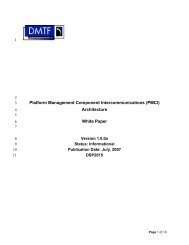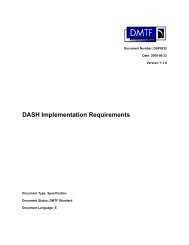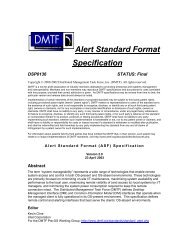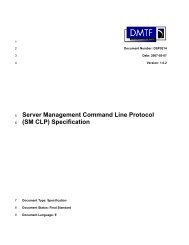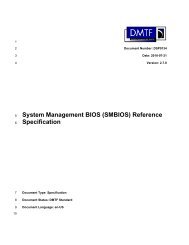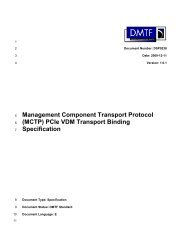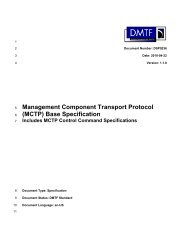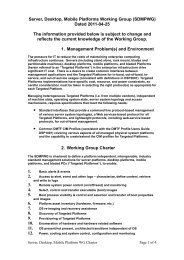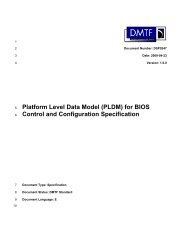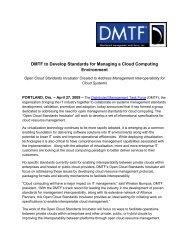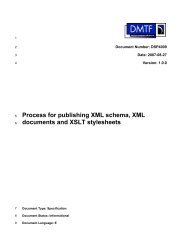DSP0237 - DMTF
DSP0237 - DMTF
DSP0237 - DMTF
You also want an ePaper? Increase the reach of your titles
YUMPU automatically turns print PDFs into web optimized ePapers that Google loves.
MCTP SMBus/I2C Transport Binding Specification<br />
<strong>DSP0237</strong><br />
925<br />
Table 6 – Fairness Arbitration Timing Values for 400 kHz I 2 C<br />
Symbol Min Max Unit Notes<br />
T BUF 1.3 – µs Per I 2 C 400 kHz specification<br />
T START_WINDOW – 4 µs Window of time within which a device that is waiting to detect a<br />
FAIR_IDLE condition shall not detect a bus busy condition. A<br />
FAIR_IDLE condition exists when bus busy is not detected within<br />
this interval.<br />
T IDLE_WINDOW 5 20 µs A device that detects FAIR_IDLE condition shall wait for this delay<br />
before attempting to generate START. This delay accommodates<br />
the difference between the T IDLE_WINDOW intervals implemented by<br />
different devices on the bus, plus additional time to accommodate<br />
bus skews between devices that are generating START and<br />
devices that are monitoring for it. This guarantees that one party<br />
that has detected T IDLE does not generate START before other<br />
devices that are detecting T IDLE have completed their T IDLE window.<br />
Otherwise, the other devices would not see a FAIR_IDLE condition<br />
even though one occurred. (Therefore T IDLE_DELAY shall be greater<br />
than the difference between the T IDLE_WINDOW maximum and<br />
minimum.)<br />
T IDLE_DELAY 16 – µs Window of time within which a device that is waiting to detect a<br />
FAIR_IDLE condition shall not detect a bus busy condition. A<br />
FAIR_IDLE condition exists when bus busy is not detected within<br />
this interval.<br />
926<br />
927<br />
928<br />
929<br />
930<br />
6.17 MCTP Packet Timing Requirements<br />
The timing specifications shown in Table 7 are specific to MCTP packet transfers on SMBus. Timing is<br />
specified for a "point-to-point" connection. That is, timing is specified as if there were only two endpoints<br />
in direct communication on the bus. In particular, the timing specifications assume that there is no clock<br />
stretching that occurs due to other parties on the bus.<br />
931 Table 7 – Timing Specifications for MCTP Packets on SMBus/I 2 C<br />
Timing Specification Symbol Value Description<br />
Endpoint packet level retries PN1 8 Number of times a non-bridge endpoint shall<br />
retry sending an MCTP packet upon receiving a<br />
NACK during the specified window (see<br />
Figure 3). An endpoint that gets successive<br />
NACKs shall do one retry for each NACK up to at<br />
least this number of retries. This also includes<br />
bridges when bridges are transmitting as an<br />
endpoint (as opposed to a bridge transmitting<br />
from its routing functionality).<br />
Bridge packet level retries PN2 12 Number of times an MCTP bridge (when<br />
transmitting packet for routing) shall retry<br />
sending an MCTP packet upon receiving a<br />
NACK during the specified window (see<br />
Figure 3). A bridge shall do one retry on each<br />
NACK up to this number.<br />
Packet transaction originator<br />
duration<br />
PT1a<br />
250 μs per<br />
byte [1]<br />
The overall duration shall be less than the<br />
specified interval times the number of bytes in<br />
the packet, starting from the byte following the<br />
slave byte through and including the PEC byte.<br />
Individual data byte transmissions may exceed<br />
the specification provided the cumulative<br />
32 <strong>DMTF</strong> Standard Version 1.0.0



